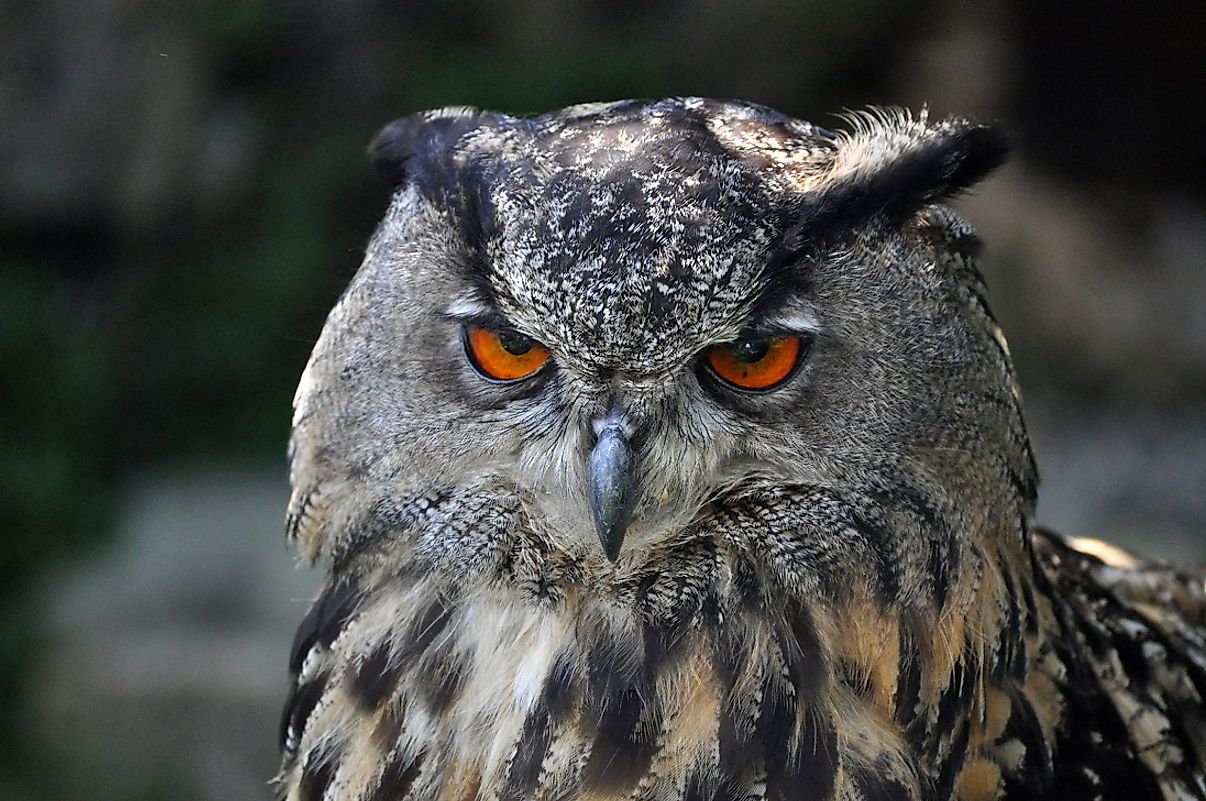Eurasian Eagle-Owl Facts: Animals of Europe

5. Physical Description
The Eurasian eagle-owl belongs to the Family Strigidae and the Genus Bubo. This bird is among the largest species of owls in the world, and can measure 30 inches in length with an impressive wing span of over six feet. The Eurasian eagle-owl usually weighs somewhere between two-and-a-half and ten pounds, with the males being slightly smaller in size and stature than their female counterparts. Physical characteristics specific to this species of owl include tufted "ears" of feathers, orange eyes, dense bodies, and black beaks, as well as barred wings and tails. The feathers of this species are largely brown, streaks with black plumage. The areas on the bird’s underbelly are lighter in tone, while the Eurasian eagle-owl's throat is white. The facial disc on the Eurasian eagle-owl is grey in color and concave-shaped.
4. Diet
In terms of its diet, the Eurasian eagle-owl typically feeds on an array of small animals, including such creatures as rabbits, rodents, birds, insects, fish, amphibians, and reptiles. These ever watchful and powerful birds prefer to hunt during the dark, nighttime hours, and search out their prey while resting on perches or flying at a low altitude. The Eurasian eagle-owl is gifted with both acute eyesight and excellent hearing abilities, which combine to enable the bird to effectively find and catch its prey. Its innate and perceptive sense of sound is attuned to pick up on even the slightest sound. This natural trait inadvertently serves to aid the Eurasian eagle-owl in its never ending hunt for food by serving to reveal the precise location of any animal the bird deems to be fitting for its next meal.
3. Habitat and Range
Eurasian eagle-owls can be found throughout much of Europe and Asia, as well as some far northern parts of Africa near the Mediterranean coast.These birds make their homes in areas where food is most plentiful. They’re suited to living in a wide variety of terrains, including forests, isolated farmlands, and landscapes featuring high cliffs upon which the birds can safely perch while hunting for the prey animals that wander on the grassy areas below. Habitats for the Eurasian eagle-owl can range from rocky mountainous areas to water-logged marshlands. Eurasian eagle-owls can also be found in some of the world’s most treacherous mountain ranges, including the Asian Himalayas, the Alps of Europe, and the Tibetan Plateau. The International Union for the Conservation of Nature's most recent Red List of Threatened Species, working in collaboration with BirdLife International, classifies Eurasian eagle-owls as a species of "Least Concern", considering their large populations and the massive geographical range of their diaspora. Still, these birds face threats from human activities, such as hunting and accidents involving automobile traffic. Many countries have implemented measures to protect and increase their respective Eurasian eagle-owl populations.
2. Behavior
The Eurasian eagle-owl is a highly skilled flier, and one that skims through the air using long, quick glides and shallow wing beats. These highly territorial birds are fearsome and highly effective hunters. As a so called “top predator”, the Eurasian eagle-owl faces few, if any, threats from other predatory animals, as it sits upon the upper tier of the food chain. These birds are mostly active at night, preferring to sleep during the daylight hours. Eurasian eagle-owls are also for their ability to make an array of vocal sounds, which are used for communicating such information to others as territorial claims and searching for a mate. These birds are sometimes tamed by humans and trained to control pest infestations.
1. Reproduction
The nests of Eurasian eagle-owls are usually located on rocky ledges or in caves, as well as in cracks along mountainous cliffs. After the female lays her eggs, she spends the majority of her time incubating them, while her male partner is responsible for finding food. Once they break free of their eggs, baby Eurasian eagle-owls begin opening their eyes after a period of several days. They grow rapidly thereafter, and during that time it’s important for both of parents to work hard to ensure that their young ones are sufficiently fed so that they can become healthy and strong. Eurasian eagle-owls reach maturity at about two to three years of age. In the wild, Eurasian eagle-owls can live for approximately 20 years, which becomes even longer when kept in captivity and looked after well.











